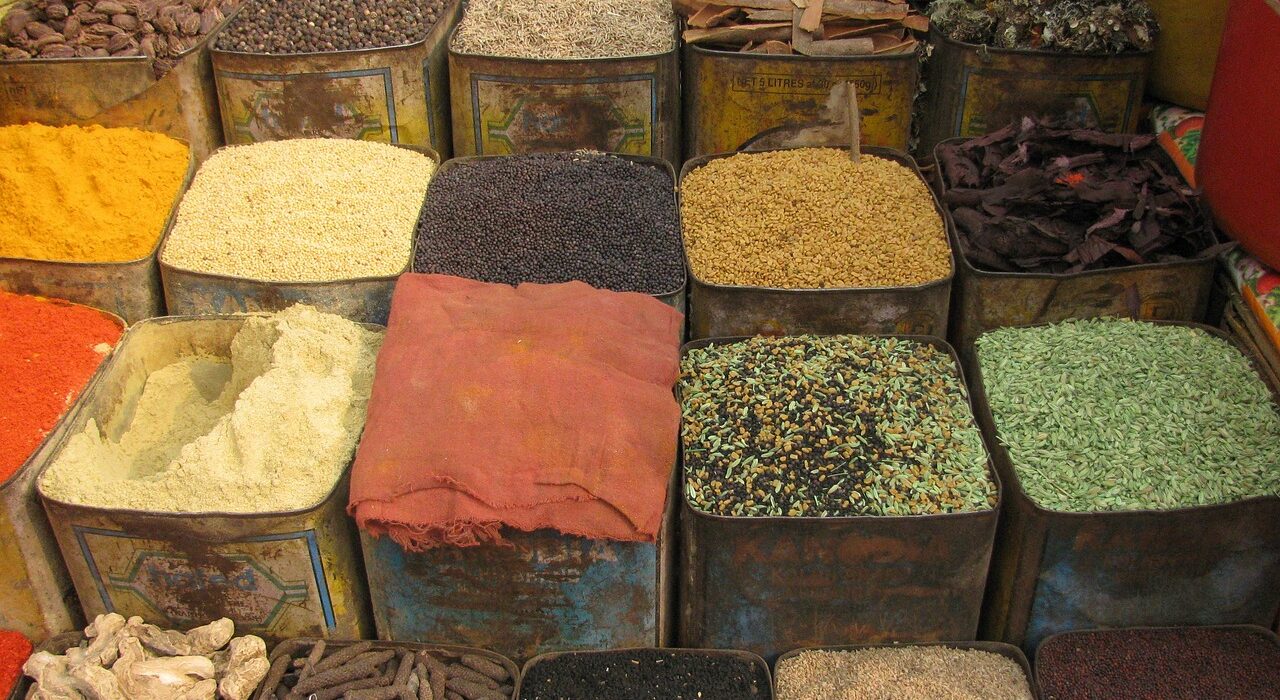Indian foods or cuisines get its flavorful aroma from the usage of subtle and sophisticated herbs and spices. These herbs and spices characterize any Indian cuisine and play a very important role in Indian cooking. No Indian food is complete without the spices. Spices in India has a great role to play in adding flavor to the daily food. Some spices are used for making the food more flavorful, some spices are used for adding special aroma to the food whereas some spices are used for complementing other spices in the food.
In the ancient times, spices were regarded as precious as gold and such the variety of spices in India that traders from foreign countries used to sail to India for the trading of spices. India plays a very important role in the world market of spices. The spices in India are broadly categorized into three categories – basic, complementary and aromatic.
The basic spices are the ones that are used in most of our daily cooking. These spices are the basic stuff that you would need in your everyday cooking. The basic spices include jeera or cumin seeds, coriander seeds, black mustard seeds, turmeric, red chili in both powder and whole forms, Asafetida or hing etc. The complementary spices are the ones that are specially added to the Indian cooking to add some extra flavor to the food. These spices are used in combination of both basic and aromatic spices depending upon the dish that is being prepared. This category of spices includes fennel seeds, fenugreek seeds, nigella seeds, carom seeds and some others. The aromatic spices, as the name suggests, are the spices that add aroma to the food. The most commonly used aromatic spices are green & black cardamom, cinnamon sticks, cloves, nutmeg, mace, white & black peppercorns, saffron and bay leaves.

Certain spices in India also bestow certain medicinal benefits as well. The most common spice, turmeric, is one among them. Turmeric is an antioxidant and is known to fight and manage cancer. Turmeric also helps in curing inflammation of body joints and also in detoxification of liver. Asafetida or hing is useful in treating asthma, coughs and bronchitis. It also helps in improving digestion along with giving flavor to the food. Ginger, a commonly used herb, is beneficial in relieving from cold & cough, joint pains and regulating blood pressure. Other spices like black peppercorns, cumin seeds, cardamoms, cinnamon, clove and saffron also fall under this category.
The spices in India is a vast area of exploration. Just one blog post is not enough to describe every intricate detail of the spices in India. However, one thing can be stated that if you want your food to be spicy, flavorful and aromatic Indian spices would be your first choice.
I’m taking the #MyFriendAlexa campaign by Blogchatter to take my blog to the next level






Vinay Leo R.
I agree. Spice is very important in cooking. 🙂 Some of my favorite dishes are spicy ones!
Sham
Yes very true… Indian spices add flavour, colour and aroma to the food and make it tastier 🙂
keerthi vydyula
The one crucial element in Indian cuisine – Maharaja of spices is Turmeric for me!! A glass of warm milk with haldi and kaali mirch powder is my favorite!
I know its not a common choice among others but i don’t know why but i like it a lot.!
Sham
I agree with you about that Maharaja of spices Turmeric. I’ve seen people having milk with haldi but black pepper is something new to me. Interesting 🙂
anupriya
It is the spices that make Indian food so varied and tasteful. The health benefits of these spices are an added advantage.
Sham
Yes absolutely… Spices in India not only have the flavouring property but have medicinal value too. Thanks for reading and commenting on my post.
Ashwini Dodani
That’s a great description of the spices there. While I cook little and into that phase of learning every day, I can relate to all the things you have written here. Thanks for this 🙂
Sham
Thanks for your kind words Ashwini. Am glad that you liked the post. I’m passionate about cooking and I thought this would be a good post in this genre.
dr. Bushra
Turmeric contains so many health benefits and we Indians used it so much in many ways. Never known the category of spices learned a lot through this post
Sham
Thank you so much for visiting my blog. Your comment means a lot. Am glad that my post could add some value to your knowledge and you got to know something new.
Sabeeka Lambe
Superb post and so true what you said there – the attitude of those cooking and serving are so important… Turmeric is my favorite when it comes to using spices for their medicinal properties.. and cumin is a close second.. packed with numerous benefits
Sham
Thanks Sabeeka for stopping by my blog and your comment 🙂
Yes very true about the medicinal aspects of the spices – Turmeric leads the way!!
Am glad that you liked the post 🙂
Disha
People don’t believe me but I eat even raw turmeric. Strangely I like it. And, again a wonderful post from you. Your posts are detailed & loaded with info!
Sham
Thank you so much Disha for your kind words 🙂
I used to have raw turmeric too. Its not the raw turmeric powder, right?
Try raw turmeric with little bit of honey… it tastes good and has good effect on health too 🙂
Kavita Singh
That is so true, one blog post is not enough to mention the aromatic and healthy spices of India. I loved reading your blog.
Sham
Thank you so much Kavita for visiting my blog and your comment.
Yes that’s why I did not want to make it lengthy by feeding all the information about spices in India. Will come up with different posts covering different aspects of spices… Stay tuned 🙂
Shalini
Now that’s awesome! I cannot imagine food without the usage of at least one spice or herb! This is great, Sham 🙂
Sham
Thank you Shalini for your kind words. The aroma is the first thing that makes people feel how the food would be!!
Amrita Basu (Misra)
A balance of spices make the flavours beautiful. Indian spices are my favourite too.
Sham
Thank you Amrita for your comment. Without spices no food gonna be tasting good 🙂
Sushmita
Oh! For me everything is just spice for flavouring! Nice read!
Sham
Thanks for your comment Sushmita… Am glad you liked the post. No food tastes good without a proper balance of spices!!
keerthi vydyula
Sham, I am nominating you for “The Mystery Blogger Award” under the category of Food & Cooking. Check out the below link for additional details. It was a pleasure to get to know you during MFA campaign!
Sham
Thank you so much Keerthi for the gesture… That’s so sweet of you 🙂
It has been a pleasure me as well to connect with you and your blog through the MFA campaign 🙂
Nayantara Hegde
I love how spices play together and create a new flavour altogether. India has such a wide variety of spices and flavourings. And every spice is unique in its own way.
Sham
Yes Nayantara, I agree with you on this. Spices play a big role in our every day food.
Thank you for reading my post and sharing a thoughtful comment on this.
Alpana Deo
Spices makes the food flavorful but over use can go the other way. I agree with the quote you shared in the image. Attitude, mood matters a lot when someone is cooking. No wonders meals cooked my mom always tastes scrumptious.
#MothersGurukulreads
#MyFriendAlexa
Sham
Thanks for reading my post sharing a thoughtful comment on this. Yes, food made by moms are always the tastiest 🙂
Kalpana
There is a saying – Variety is the spice of life – and even in spices we want variety, don’t we? Fascinating article about spices.
Shamik
Yes absolutely Kalpana. Without variety life will become so mundane 🙁
Abhijit Ray
This is a very well organised blog. I read a few posts, two to be precise. One on spices and another on the interest of the blogger on cooking. Both articles are written lucidly. The one on Indian spices is informative and thought provoking. This blog is a must read for all those who are interested in cooking and eating (in a good way as a foodie)
Shamik
Thank you so much Sir for your kind words. Your comment meant a lot to me and inspiring to excel at my blogging spree. I’m glad you liked my posts and appreciate my efforts.
Jayanthi
Nice to read about the different spices!
Shamik
Thanks Jayanthi 🙂
BellyBytes
Spices add to the flavour of food and it is no wonder that colonisation began with the spice trade!
Sham
Yes, without spice we cannot think India food. Thanks for reading my post and commenting.
ankita
There truly is a vast variety of spices used in India. Fun fact is that a few of them rule over specific cuisines…
Sham
Yeah, true that Ankita. Indian cuisine cannot be thought without spices.
pythoroshan
Very helpful post for those who need a quick handy guide 🙂
Sham
Thank you so much for reading and sharing your thought.
Esha Chakraborty
I love spices especially home-grinds.. Nice write up
Sham
Yes, the home-grind ones have great aroma and give great flavor to any dish. Thanks for reading the post and sharing your thought.
momlearningwithbaby
Somehow I am feeling the aromatic fragrance of these spices, the aura of raw spices is my weakness. Black pepper is my favorite.
Sham
Thank you for your sharing your thoughts on this. Yes spices are the integral part of our everyday cooking. Indian food cannot be thought without spices.
alpanadeo
Indian spices are the heart of Indian cuisine. Each one is special in its own way and gives a new dimension to any dish.
Sham
Oh yes and we cannot think of Indian recipe without spices. Thanks for reading the post and sharing your thoughts.
Surbhi Prapanna
Yes Indian spices are one of the most important part if Indian cuisin and they have lots of health benefit too. turmeric is one of my favorite spice and I had observed so many health benefits of it. #Surbhireads #Myfriendalexa
Shamik
True that Surbhi. Thanks for sharing your thoughts 🙂
Rashi Roy
Yes, I love spicy food and our Indian spices have medicinal properties too 🙂
Shamik
Yes, absolutely true Rashi. Without spices no food tastes good.
Shweta Suresh
There’s no life in food without spices. It’s undoubtedly the most important part of our food!
Shamik
Yes absolutely Shweta!!
gautam wadhwani
We have an export business of spices and agriculture-based in India.
kindly visit our website-
https://viversagroexports.com
Tradologie
Nice Article! You post very informative article on this topic, its very helpful for users.
Shamik
Thank you so much. I’m glad that you liked the post.
Bhim Singh
Thank you for such a great and informative Article. this is very helpful for those people who wants to know something about Indian Spices. And Spices are always increase the taste of food.
Shamik
Thank you so much for your comment. I’m glad that my post is a value addition for you.
Tinu
Nice content, very informative and productive page all the information on spices is covered
Shamik
Thank you so much Tinu for visiting my blog, reading my post and adding your comment 🙂 I’m glad you liked the post.
Nutsnspices
Amazing Article, Thank you!. I am very glad to read your informative & practical blog about Indian Spices Powder. | buy spices online. Kindly Keep Updating Your Blog.
Shamik
Thank you so much. I’m glad that you found the post informative and value adding.
Nuts N Spices
Amazing Article, Thank you!. I am very glad to read your informative & practical blog about Indian Spices Powder. | buy spices online. Kindly Keep Updating Your Blog.
Shamik
Thank you so much. I’m glad my post added some value to your information bank.
Merchant Exporter from India
I am Mohit Singh, owner of Dekentmerchandise. I read your blog, it’s very nice. I appreciate you. I am the Spices supplier in India.
Shamik
Thanks Mr. Mohit. I’m glad you liked my post.
druera
NICE BLOG
Shamik
Thank you!! I’m glad you liked my blog.